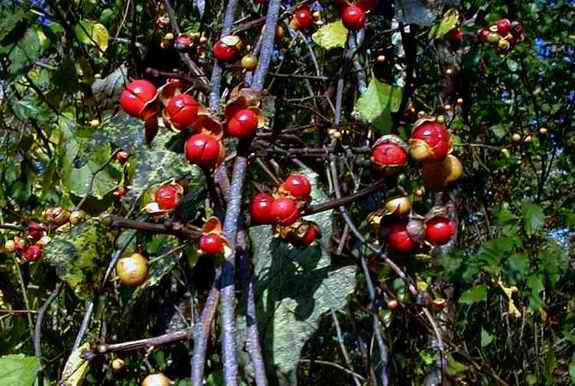|
Return to Hiker's Notebook Home Page
Common Names: American Bittersweet, false bittersweet, climbing bittersweet, shrubby bittersweet, Jacob's ladder, staff tree, fever-twitch, Roxbury waxwork, climbing orange-root; Asiatic Bittersweet, oriental bittersweet, round-leaved bittersweet. Scientific Names: Celastrus scandens - The generic name is from the Greek kelastros which is the name of a Mediterranean evergreen tree, though there is no known association between the two plants; scando is the Latin infinitive verb form "to climb," referring here to the nature of the vine. Celastrus orbiculatus - orbiculatus is Latin for round, referring to the round leaves of Asiatic relative to American Bittersweet.
The many names of the American bittersweet attest to its distinctive appearance and to the wide range of its native habitat, from Quebec to Georgia in the east and from North Dakota to Oklahoma in the west. It is called "climbing" and "shrubby" because it is a vine that uses other plants for support, becoming so thickly ramose that it often looks like a small shrub. Jacob's ladder also refers to its viny disposition. It is called "staff tree" as it is the most recognizable member of the Staff Tree Family (Celastraceae) of some 400 species. "Fever-twitch" refers to its various medicinal properties, twitch meaning "to pull at with a quick, slight jerk." Roxbury is a residential area near Boston, the yellow color of the berries before they part to reveal the red, fleshy arils that contain the seeds appearing waxy to the local inhabitants. The yellow-orange coloration of its roots gives rise to the last moniker, the climbing orange-root.
The American bittersweet is being displaced by the invasive Asiatic bittersweet to the extent that in some areas the former is now considered a protected species. This is somewhat ironic in that the latter was intentionally introduced into North America in the 1860's as an ornamental plant. The success of C. orbiculatus is due to a variety of factors which conflate to produce a prodigious competitor. The fruits of the invasive species are a brighter red and more prolific than those of its rival so that birds are more likely to be attracted to them, thereby contributing to the wide dispersal of the seeds. The seeds thus spread have a higher statistical probability of germinating. The germinating sprouts are better at photosynthesis, as they absorb light across a broader range of the frequency spectrum. The Asiatic bittersweet also spreads by above ground stems called stolons, by underground stems called rhizomes, and by sending shoots up directly from the roots. It is no wonder that it is one of North America's most invasive plants.
American and Asiatic bittersweet can be distinguished by three subtle but readily recognizable features. In consonance with its species name, C. orbiculatus has more rounded leaves than C. scandens, whose leaves are ovate. In addition, the former has blunt thorns along the stem whereas the latter has none. The most distinguishable feature is the location of the berries. American bittersweet berries are at the ends of the vine twigs, while those of the Asiatic bittersweet are along the entire length of the vine. However, their close genetic association has likely led to some interbreeding so that the presence of both lateral and terminal berries on the same vine may indicate an intermediate combination, an Asian-American bittersweet.
Another name for the American bittersweet is the "false bittersweet," implying that there must be a "real bittersweet," both of which are presumably called bittersweet for a reason beyond bittersweet's association with the poetic connotation of irony. Solanum dulcamara, commonly known as bittersweet nightshade is a native of Europe that was also introduced to North America. It is the "true bittersweet." The species name is from the Latin dulcis meaning sweet and amarus meaning bitter, written in the Middle Ages as amaradulcis, or bittersweet. This was to describe the taste of the roots and stems that, if chewed, were first bitter and then sweet. The twigs of the bittersweet nightshade were known to have a bittersweet taste since they had been used in Europe since the 13th Century to treat a variety of ailments. Carl Linnaeus, the Swedish taxonomist, considered S. dulcamara as a superior remedy for all manner of inflammatory conditions. He thus gave the nightshade genus the name Solanum which is from the Latin solor which means to comfort or console. Ironically, the orange-red berries of the bittersweet nightshade are quite toxic, containing the alkaloid Solanine which is a narcotic that paralyzes the central nervous system that can lead to a convulsive death.
American bittersweet has orange-red berries, is a medicinal and has a bittersweet taste. So, with syllogistic logic, early colonists named this new bittersweet-like plant the "false bittersweet." The berries are also toxic, ingestion resulting in relatively severe though not fatal digestive convulsions. The bark, however, was made into a tea by Indians and used as a diuretic and to ease the pain of childbirth. The leaves were used to treat diarrhea and dysentery. Some tribes boiled the inner bark of the plant to remove the bitter taste and ate it, in some cases as refection of last resort. Early colonial herbalists learned of the attributes of C. scandens from the Indians and extended its uses to the treatment of chronic liver maladies and rheumatism and as the basis for an ointment for skin eruptions. It is considered by modern herbalists to be cardio-active. |
